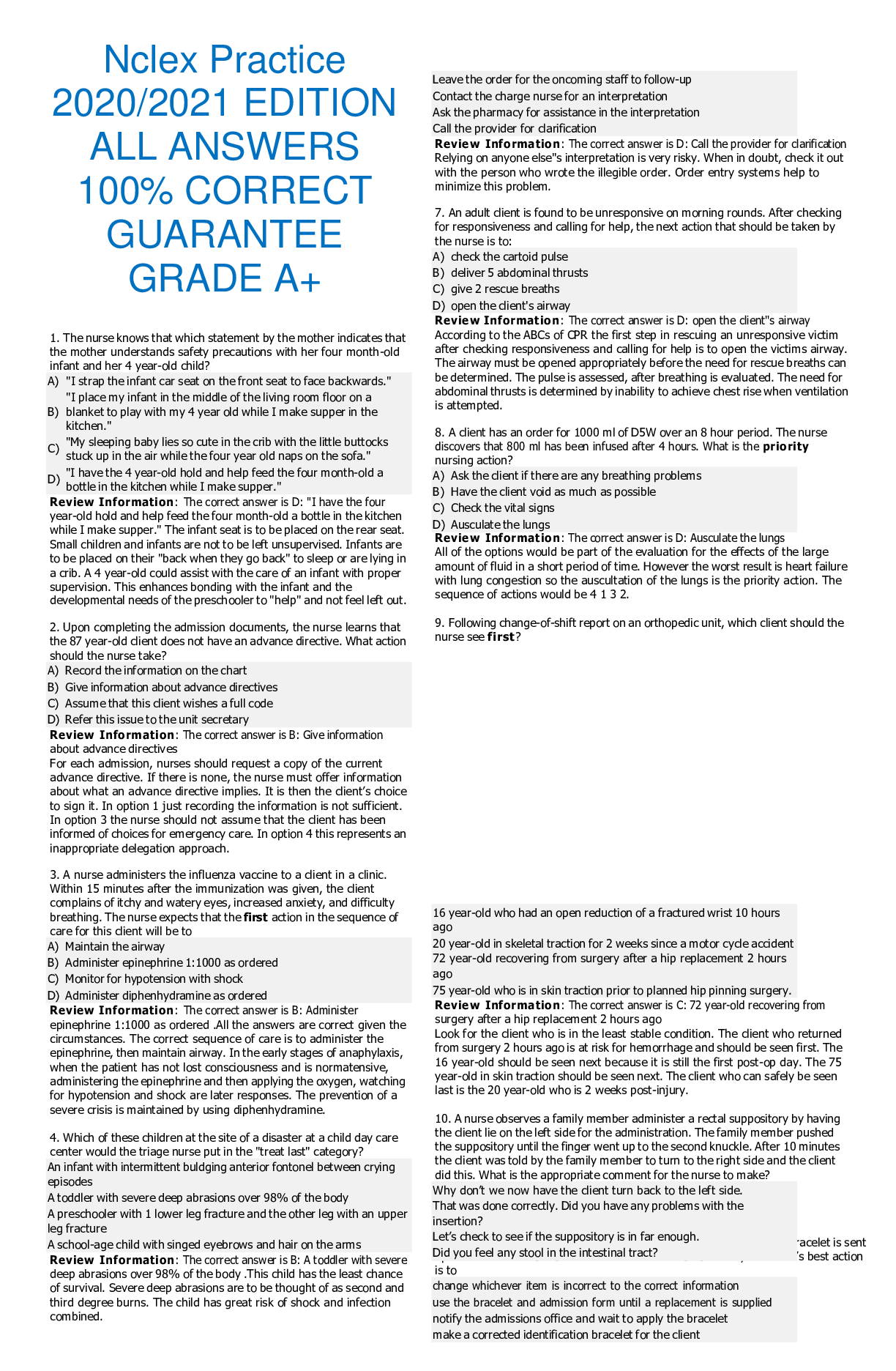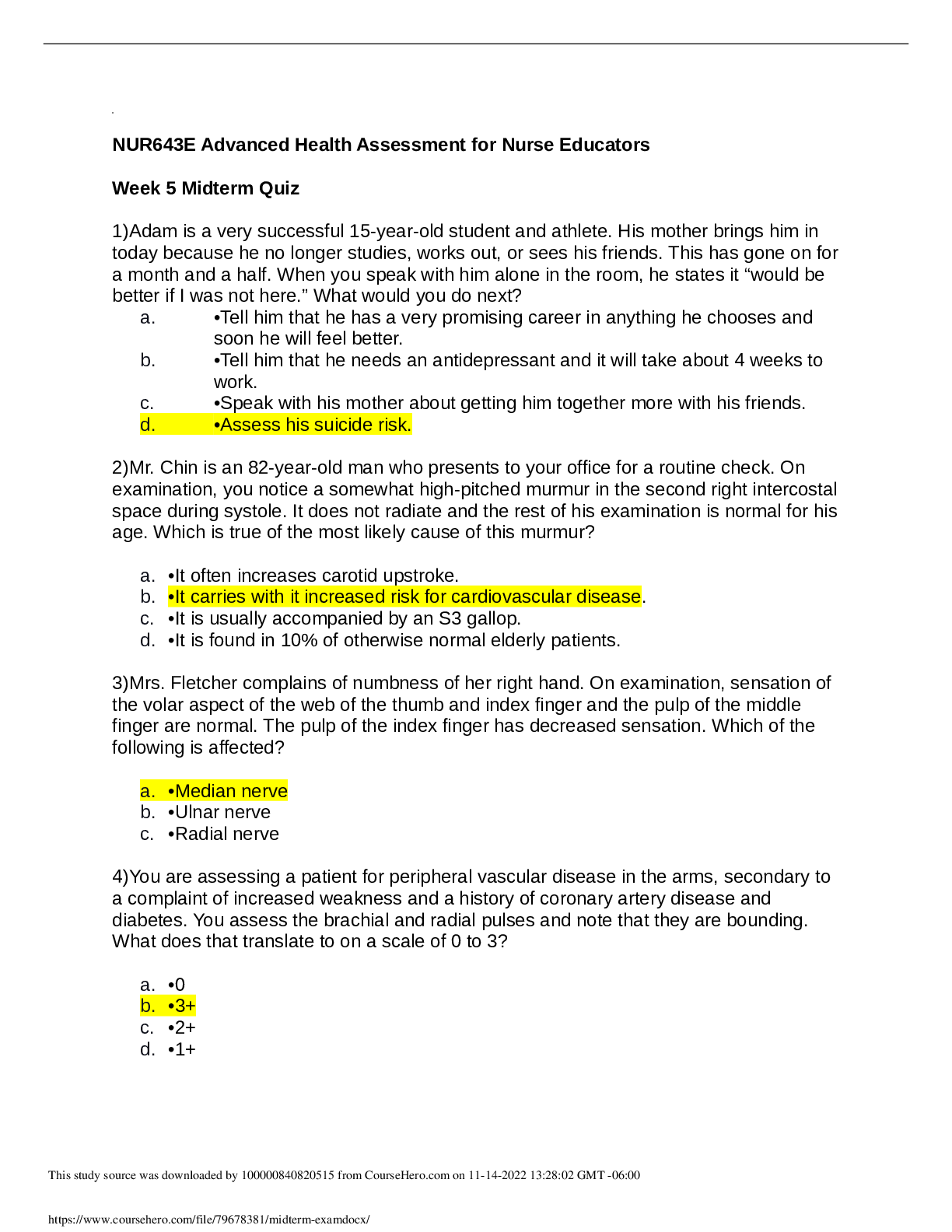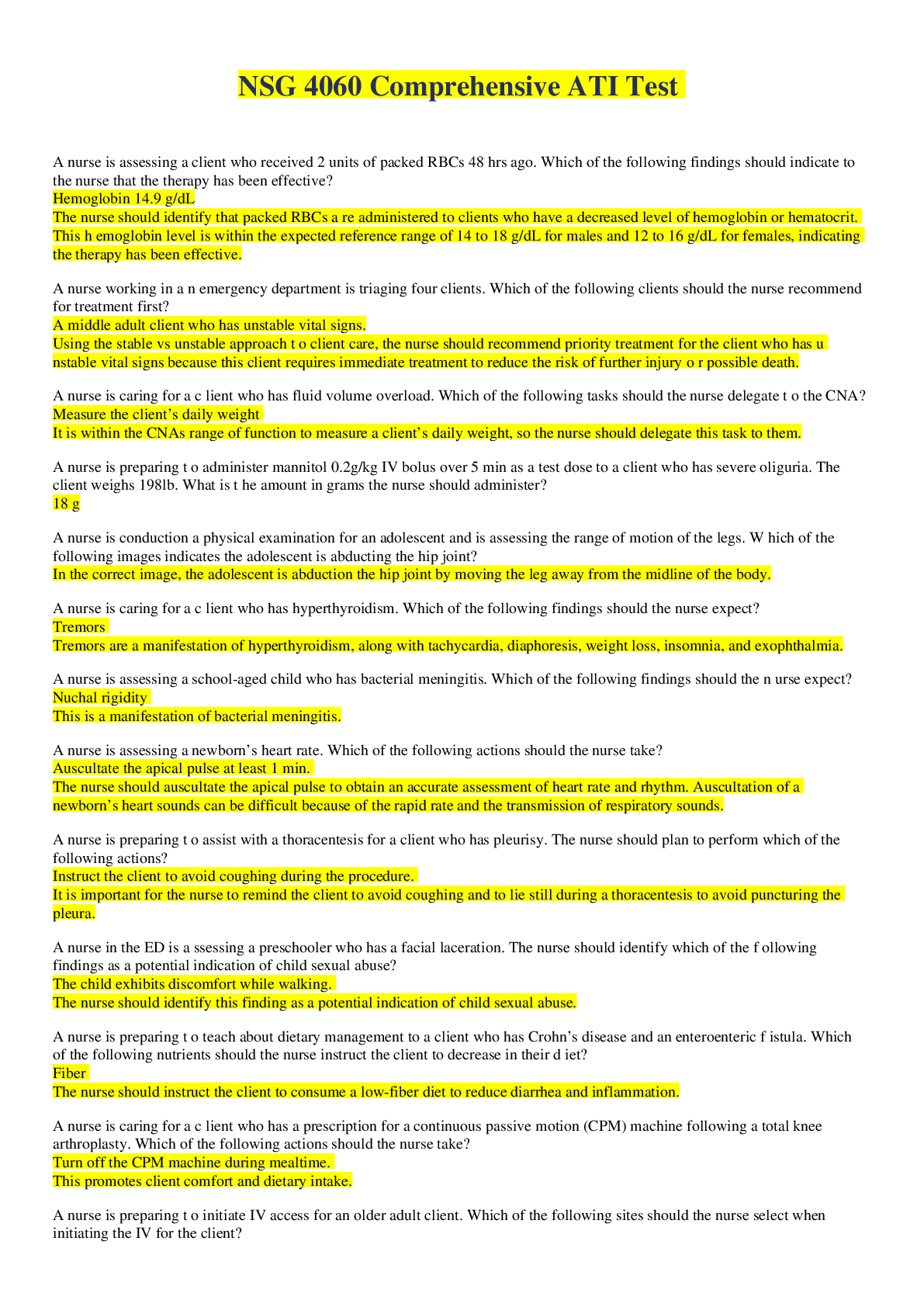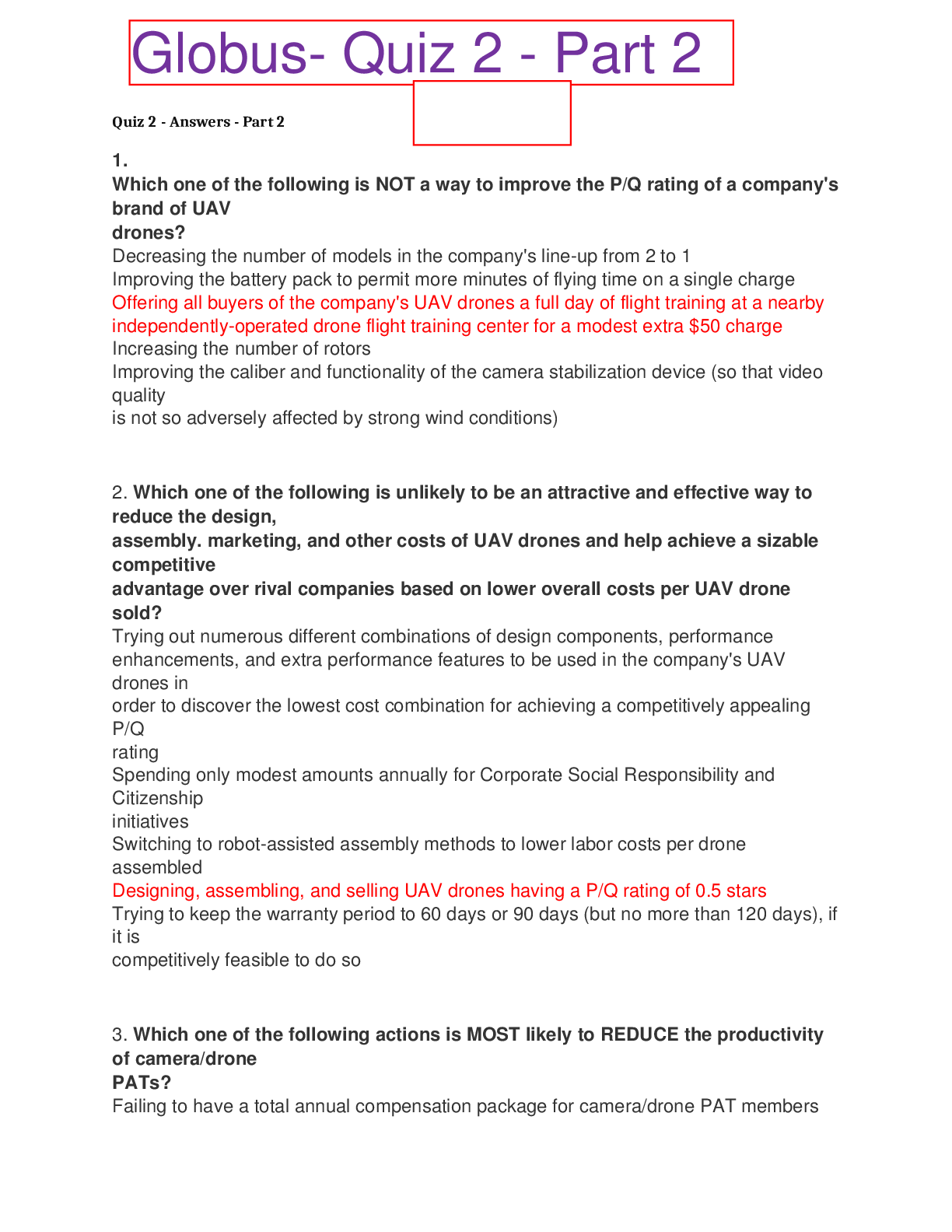Health Care > QUESTIONS & ANSWERS > 1. Ch. 4 The provider network ALL SOLUTION LATEST EDITION 2023 AID GRADE A+ (All)
1. Ch. 4 The provider network ALL SOLUTION LATEST EDITION 2023 AID GRADE A+
Document Content and Description Below
Contractual goals from a health plan perspective (Reasons why a health plan wants to contract with providers) 1. Obtain favorable pricing (less than full billed amounts) 2. Obtain payments terms tha... t result in an underwriting gain 3. Get the provider to agree to provide services to the plan's members 4. Meet the service area access standards required by the states and Medicare 5. Obtain contractual agreement for several clauses, many of which are required by the states and Medicare Other contractual Requirements established by the states and Medicaren 1. Submit claims directly to the plan, not the member 2. Not balance bill the member for any amount above the agree-upon payment terms 3. Hold harmless the member (not bill for any amounts owed by the plan) 4. Cooperate with the plan's utilization management program 5. Cooperate with the plan's quality management program 6. Give the plan the right to audit clinical and billing data for care provided to plan members 7. Not discriminate (and other similar requirements) Contractual goal from a health plan perspective (Reasons why a provider wants to contract with a health plan) 1. Obtain favorable pricing when in a strong negotiating position 2. Ensure that it will not be excluded from the network of a large player 3. Receive direct payment from the plan, thereby avoiding the need to collect from the the patient 4. Receive timely payment (usually 30 days or less) 5. Have plan members directed or steered to it 6. Not lose business (or medical staff) as a payer steers members to others who are contracted providers 7. Receive defined rights around disputing claims and payments What a contract management system? A software used by payor that manages thousands of provider contracts Capabilities of a well-functioning contract management system 1. Identify network gaps or where provider recruiting is most needed 2. Track recruiting efforts, provide reminders, and generate recruiting reports 3. Generate new contract blanks and new contracts with information filled in 4. Store copies of different versions of any provider's contract 5. Track and manage permissions and sign-offs on contracts 6. Track and report contract changes for each provider 7. Store images of signed documents and convert imaged documents into machine-readable formats 8. Support an entirely paperless contracting process 9. Provide early notification or reminders for upcoming actions such as recredentialing or renegotiation 10. Direct electronic feed of required demographic information to other internal functions 11. Direct electronic feed of market-facing systems such internet physician searches 12. Be searchable on multiple attributes 13. Analyze the potential impact of changes in contract terms What effects a plan's access needs 1. Need to improve size to compete against a larger plan 2. Expansion of an HMO's service area 3. Areas with high concentrations of members 4. New type of plan such as an MA or managed Medicaid plan 5. Satisfy a state or federal requirement 6. Contract with physicians who use a newly contracted hospital Types of physicians and other professional providers 1. PCP and SCP - for traditional HMO, the distinction between PCP and SCP is very important becauce the PCP acts as a gate keeper and must authorize any visits to a specialist 2. Hospital-based physicians - specialties include radiology, anesthesiology, pathology, emergency medicine, and hospitalist. These physicians often have exclusive rights at a hospital, so they are reluctant to contract for anything less than full charges. 3. Nonphysician or mid-level practitioners that provide primary care (PA and NP). These are a great asset in managed care because they deliver excellent primary care, tend to spend more time with patients, and are well accepted by most members. 4. Mental health providers 5. Other types of professionals Type of mental health providers 1. Psychiatrist - a physician who specializes in a mental health and is able to prescribe drugs 2. Psychologist - has a doctoral degree in psychology and two years or supervised professional experience 3. Clinical social worker - a counselor with a master's degree in social work 4. Licensed professional counselor - has a master's degree in psychology, counseling, or a related field 5. Certified alcohol and drug abuse counselor - has a specific clinical training in alcohol and drug abuse and provides individual and group counseling 6. Psychiatric nurse practitioner or nurse psychotherapist - a registered nurse practitioner with special training in psychiatric and mental health nursing 7. Marital and family therapist - a counselor with a master's degree and special training in marital and family therapy Other types of professionals Contracting with physicians and other professionals 1. To provide good access, typically contract with more than the minimum required 2. Contracting approach varies by type 3. Physician credentialing 4. On-site office evaluation (done as part of credentialing process) 5. Orientation usually done through internet 6. Removing physicians from the network Individual and Group Physician contracting pros and cons IPA contracting pros and cons Faculty Practice Plan vs. PCMH contracting pros and cons Contracting considerations vary by type of physician groups (1) 1. Individual physicians - advantage is the direct relationship with the physician. Disadvantage is the effort to maintain the relationship is large for just one physician. 2. Medical groups - advantage is the same contracting effort yields a higher number of physicians. Disadvantage is that if the relationship is terminated then there is greater disruption in patient care. 3. Independent practice associations (IPAs) advantage: a large number of providers come along with the contract, the IPA may accept more financial risk, and some IPAs perform network management, credentialing, and medical management. disadvantage: the IPA can hold a considerable portion of the delivery system hostage to negotiations, and the plan's ability to select and deselect individual physicians is limited Contracting considerations vary by type of physician groups (2) 4. Faculty practice plans (medical groups that are organized around teaching programs) advantages: these programs provide highly-specialized care and they add prestige to the plan by virtue of their reputation for quality care Challenges include: tend to be less cost effective in their practice styles, and they are not set-up for case management, so care is not well coordinated 5. Physicians in integrated delivery systems (IDS) - there are two types: a) Hospital systems that affiliate with private physicians b) Hospital systems that employ physicians - these often have substantial negotiating leverage 6. Patient-centered medical homes - these coordinate all care for a group of patients 7. Specialty management companies - these focus on managing very specialized services using physicians (e.g. single-specialty case management of neonatal care) Physician credentialing overview 1. Initial credentialing is carried out during recruiting 2. HMOs require re-credentialing every 36 months 3. Most PPOs also require re-credentialing Elements of a typical physician credentialing application 1. Demographics, licenses, and other identifiers (such as national provider identifier) 2. Education, training, and specialties 3. Practice details - such as services provided and office hours 4. Billing and remittance information 5. Hospital admitting privileges 6. Professional liability insurance 7. Work history and references 8. Disclosure questions - such as suspension from government programs or felony convictions 9. Images of supporting documents - such as a state license certificate Information provided to the physician during orientation 1. Policies and procedures for authorizations 2. Information on the quality management program and peer review 3. Credentialing and recredentialing requirements 4. Necessary forms and paperwork 5. Plan member grievance procedures 6. Payment rates and schedule 7. Plan contact information 8. Network information, such as contracted hospitals and other facilities Components of network monitoring 1. Databank (NP and HIP) 2. On-site evaluation Required for NCAQ accreditation (capacity to CONTINUED.. [Show More]
Last updated: 2 years ago
Preview 1 out of 6 pages
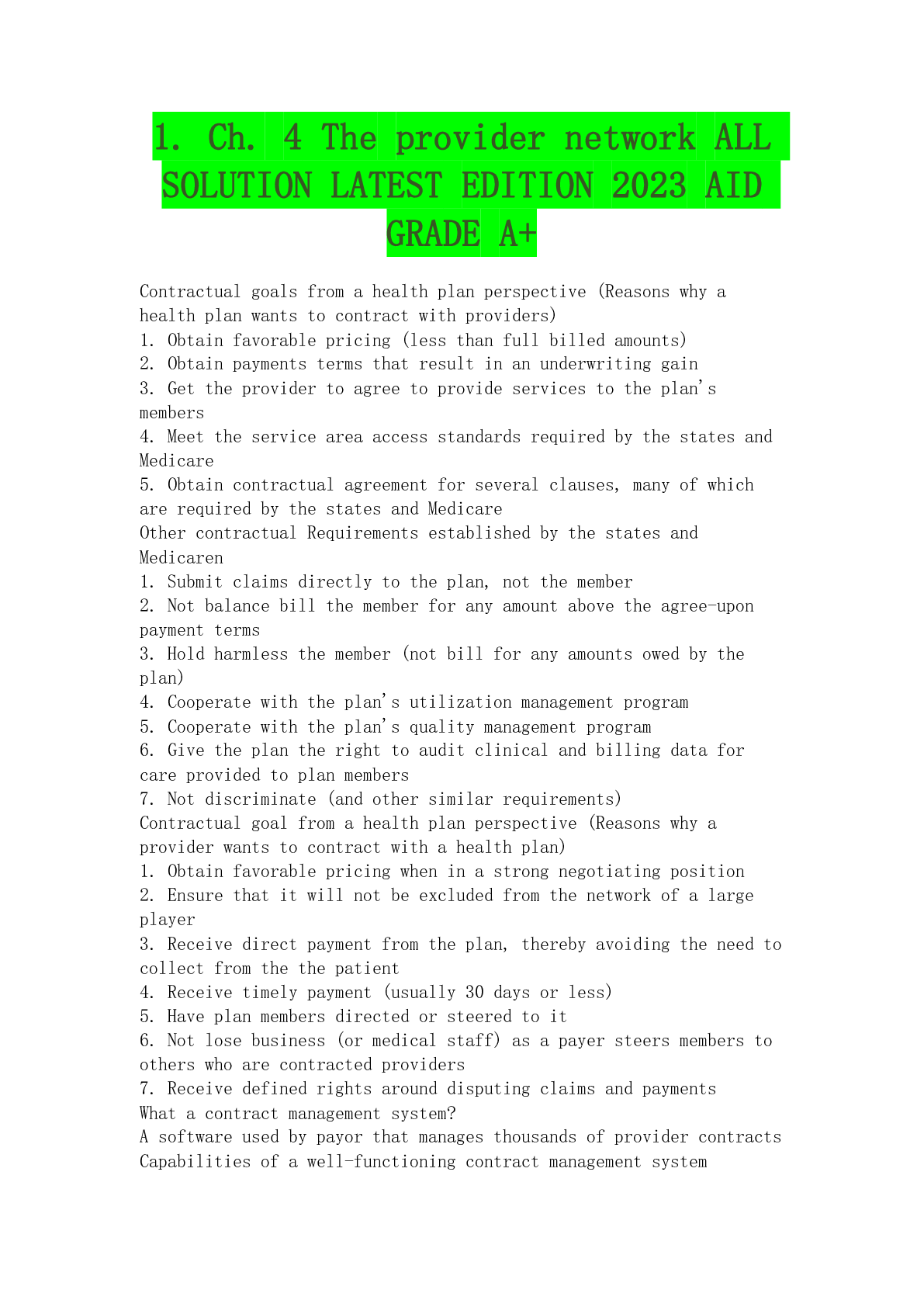
Buy this document to get the full access instantly
Instant Download Access after purchase
Buy NowInstant download
We Accept:

Reviews( 0 )
$11.50
Can't find what you want? Try our AI powered Search
Document information
Connected school, study & course
About the document
Uploaded On
Apr 15, 2023
Number of pages
6
Written in
Additional information
This document has been written for:
Uploaded
Apr 15, 2023
Downloads
0
Views
71





